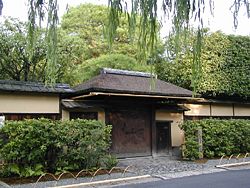
Urasenke
Encyclopedia

Schools of Japanese tea ceremony
"Schools of Japanese tea ceremony" refers to the various lines or "streams" of the Japanese Way of Tea. The word "schools" here is an English rendering of the Japanese term ryūha .-san-Senke:...
of Japanese tea ceremony
Japanese tea ceremony
The Japanese tea ceremony, also called the Way of Tea, is a Japanese cultural activity involving the ceremonial preparation and presentation of matcha, powdered green tea. In Japanese, it is called . The manner in which it is performed, or the art of its performance, is called...
. It is one of the san-Senke (three Sen houses/families); the other two are Omotesenke
Omotesenke
is the name of one of the three houses or families that count their family founder as Sen Rikyū and are dedicated to carrying forward the Way of Tea that he developed. The other two are Urasenke and Mushakōjisenke. The three are together referred to as the san-Senke...
and Mushakōjisenke.
The san-Senke derive from Sen Rikyū, and it was not until after the era of his grandson, Sen Sōtan
Sen Sotan
, also known as Genpaku Sōtan 元伯宗旦, was the grandson of the famed figure in Japanese cultural history, Sen Rikyū. He is remembered as Rikyū's third-generation successor in Kyoto through whose efforts and by whose very being, as the blood-descendant of Rikyū, the ideals and style of Japanese tea...
, that the three separate lines of the family came into being. Three sons of Sōtan each became heirs to the family name, Sen, and to the family profession of teaching the Way of Tea that their mutual family founder, Rikyū, had developed.
The original tea room of Urasenke was built by Sen Sōtan when he was contemplating retirement and having his third son take over the headship of the Sen house. He built this retirement tea room on land located next to the Sen house, on the north. It has the name "Konnichian" (今日庵; "Hut of This Day"), and from this the entire historical Urasenke estate, which is located on Ogawa street in the Kamigyo ward of Kyoto, directly north of the Omotesenke estate, is referred to by this name.
The head (iemoto
Iemoto
Iemoto is a Japanese term used to refer to the founder or current head master of a certain school of traditional Japanese art...
) of this line carries the hereditary name Sōshitsu. The present head of Urasenke is Zabōsai Genmoku Sōshitsu. He is the 16th generation in the line.
Generations
| Generation | name | religious pseudonym | ||
|---|---|---|---|---|
| 1st | Rikyū Sōeki Sen no Rikyu , is considered the historical figure with the most profound influence on chanoyu, the Japanese "Way of Tea", particularly the tradition of wabi-cha... (1522-91) |
利休 宗易 | Hōsensai | 抛筌斎 |
| 2nd | Shōan Sōjun (1546-1614) | 少庵 宗淳 | ||
| 3rd | Genpaku Sōtan (1578-1658) | 元伯 宗旦 | Totsutotsusai | 咄々斎 |
| 4th | Sensō Sōshitsu (1622-97) | 仙叟 宗室 | Rōgetsuan | 臘月庵 |
| 5th | Jōsō Sōshitsu (1673-1704) | 常叟 宗室 | Fukyūsai | 不休斎 |
| 6th | Taisō Sōshitsu (1694-1726) | 泰叟 宗室 | Rikkansai | 六閑斎 |
| 7th | Chikusō Sōshitsu (1709-33) | 竺叟 宗室 | Saisaisai | 最々斎 |
| 8th | Ittō Sōshitsu (1719-71) | 一燈 宗室 | Yūgensai | 又玄斎 |
| 9th | Sekiō Sōshitsu (1746-1801) | 石翁 宗室 | Fukensai | 不見斎 |
| 10th | Hakusō Sōshitsu (1770-1826) | 柏叟 宗室 | Nintokusai | 認得斎 |
| 11th | Seichū Sōshitsu (1810-77) | 精中 宗室 | Gengensai | 玄々斎 |
| 12th | Jikishō Sōshitsu (1852-1917) | 直叟 宗室 | Yūmyōsai | 又玅斎 |
| 13th | Tetchū Sōshitsu (1872-1924) | 鉄中 宗室 | Ennōsai | 圓能斎 |
| 14th | Sekisō Sōshitsu (1893-1964) | 碩叟 宗室 | Tantansai (AKA: Mugensai) | 淡々斎 (無限斎) |
| 15th | Hansō Sōshitsu (Sen Genshitsu) (b. April 19, 1923) | 汎叟 宗室 | Hōunsai | 鵬雲斎 |
| 16th (current iemoto) | Genmoku Sōshitsu (b. June 7, 1956) | 玄黙 宗室 | Zabōsai | 坐忘斎 |
See also
- OmotesenkeOmotesenkeis the name of one of the three houses or families that count their family founder as Sen Rikyū and are dedicated to carrying forward the Way of Tea that he developed. The other two are Urasenke and Mushakōjisenke. The three are together referred to as the san-Senke...
- Mushakōjisenke
- Japanese tea ceremonyJapanese tea ceremonyThe Japanese tea ceremony, also called the Way of Tea, is a Japanese cultural activity involving the ceremonial preparation and presentation of matcha, powdered green tea. In Japanese, it is called . The manner in which it is performed, or the art of its performance, is called...
- Schools of Japanese tea ceremonySchools of Japanese tea ceremony"Schools of Japanese tea ceremony" refers to the various lines or "streams" of the Japanese Way of Tea. The word "schools" here is an English rendering of the Japanese term ryūha .-san-Senke:...

